|
TRANSLATE THIS ARTICLE
Integral World: Exploring Theories of Everything
An independent forum for a critical discussion of the integral philosophy of Ken Wilber
 Brad Reynolds did graduate work at the California Institute of Integral Studies (CIIS) before leaving to study under Ken Wilber for a decade, and published two books reviewing Wilber's work: Embracing Reality: The Integral Vision of Ken Wilber (Tarcher, 2004), Where's Wilber At?: Ken Wilber's Integral Vision in the New Millennium (Paragon House, 2006) and God's Great Tradition of Global Wisdom: Guru Yoga-Satsang in the Integral Age (Bright Alliance, 2021). Visit: http://integralartandstudies.com Brad Reynolds did graduate work at the California Institute of Integral Studies (CIIS) before leaving to study under Ken Wilber for a decade, and published two books reviewing Wilber's work: Embracing Reality: The Integral Vision of Ken Wilber (Tarcher, 2004), Where's Wilber At?: Ken Wilber's Integral Vision in the New Millennium (Paragon House, 2006) and God's Great Tradition of Global Wisdom: Guru Yoga-Satsang in the Integral Age (Bright Alliance, 2021). Visit: http://integralartandstudies.com
True MeditationEvolution's Tool for Ego-TranscendenceBrad Reynolds
In other words, the secret to meditation is practice, practice, practice!—and surrender!—words which Westerners tend not to want to hear.
Meditation, imported from the East but now popular in the West, has several phases and stages of unfolding as a person explores the higher transpersonal spheres of consciousness development. It involves the interior evolution of consciousness or conscious awareness until we realize the truth of God or our Divine Condition. Meditation, in other words, doesn't just quiet the mind; it awakens the heart. Meditation can be used by anyone at any stage of life—even children can perform simple meditation—but generally, for most people, it begins as a regular practice as they enter the Fourth Stage of Life. Only after the egoic self has grown and emerged (in the First Three Stages of Life) does someone sense the possibility of further self-transcendence that can lead to accessing the spiritual tools (or techniques) to realize their innate enlightened condition. Meditation, therefore, becomes the real means for advancing in the Fourth Stage of Life until final Enlightenment. 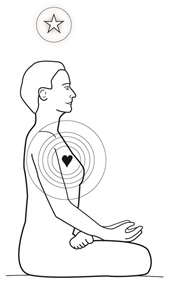
Meditation—i.e., sitting still and turning the mind inward—is the most proactive tool available to human beings for cultivating the higher temporary states of consciousness (psychic, subtle, causal, and nondual), then transforming them into permanent stages (Stages 4-7) in the evolution of consciousness. A time-honored tradition practiced for millennia, meditation is the essence of real yoga, for the physical exercises or asanas so popular today in the West are only intended to create the sturdy bodily foundation upon which silent meditation may be engaged. As Ken Wilber long ago pointed out: “Meditation is, if anything, a sustained instrumental path of transcendence… meditation is simply sustained development or growth…. It is what an individual, at this present stage of human evolution, has to do in order to develop beyond this present stage of human evolution, and advance towards only God which is the goal of all creation.” As Ramana Maharshi, one of India's most famous twentieth-century Sage, reminds us: “The experience of Self [God] is possible only for the mind that has become subtle and unmoving as a result of prolonged meditation.” In other words, the secret to meditation is practice, practice, practice!—and surrender!—words which Westerners tend not to want to hear, let alone undertake. 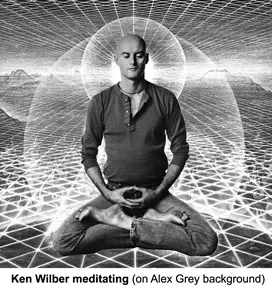
Yet, from research done by yogis in the lotus posture to scientists in the lab, we know meditation in fact is very effective for our spiritual growth and releasing egoic dilemmas and delusions. Its proficiency is also verifiable by the evidence provided by our past transpersonal heroes, those Saints, Yogis, Sages, and Siddhas who came before us demonstrating the higher possibilities of humankind. For, as they instruct us, they were only able to evolve to their higher station in life by the persistent practice of meditation or deep contemplative surrender to God. Yoga, in the end, is all about meditation (not the asanas or even breathwork, pranayama). Indeed, meditation (and self-transcendence) is at the center of all the great religious traditions of the world in their deepest esoteric core. Again, as Wilber, an advanced meditator from early adulthood (thus revealing some of his greatest insights over the years) has pointed out:
A careful survey of reports of present-day meditation shows that advanced meditation discloses, in the same order, the very same higher-structures of consciousness first discovered in historical succession by the past transcendent heroes of various epochs. That is the person today who begins and eventually completes a well-rounded meditation [practice] goes first into shamanic intuition [Fourth Stage], then subtle oneness [Fifth Stage], then causal emptiness [Sixth Stage], then final and complete enlightenment [Seventh Stage].
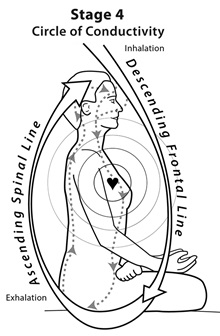
What this means, in essence, is that meditation stimulates and unfolds our further evolution into the transpersonal structures of consciousness. Meditation accesses these higher realms in a deliberate and prolonged fashion by loosening and surrendering our current level of adaptation and growth, which for most people today, generally speaking, is the self-sense adapting to the mental-egoic level of the Third Stage of Life. This is one reason why real meditation does not really begin until the Third Stage is nearly complete, for subjectivity must first be established before it can be transcended. This is why Adi Da, for example, has explained: “You must become human before you can become spiritual.” It's not that children and young people cannot meditate, for they certainly can, since quieting the mind and following the breath is beneficial for anyone. As Adi Da points out, meditation at those earlier stages involves an opportunity to feel “the Mystery” (or God and their relationship to their Guru), to feel their present Happiness. Conversion to the Fourth Stage of Life, the most difficult stage of transition (into the transpersonal domains), involves the stabilization of the “Circle of Conductivity” or learning to breathe the kundalini life-force around the frontal and spinal currents of the body-mind (as the “Advanced Stage 4” diagram indicates). Meditation, therefore, in truth is a whole body exercise, even though the body sits still effortlessly breathing Spirit to Infinity. Sustained, advanced meditation also involves transcending the “mindfulness” or the simple witnessing of your arising thoughts, emotions, and reactions (based on the self-contraction) by feeling from the heart in ever-present Divine Communion. The “I” ultimately dissolves into God or Consciousness Itself. Adi Da explains: “Conventional meditation is inwardness, or remedy by subjectivity. Real meditation… is a process of awakening from subjectivity. The process is gradual in its perfection, but its Truth is certain from the beginning.” Ramana Maharshi clarifies: “Because God remains the nature of the Self, shining as 'I' in the heart, because the scriptures declare that thought itself is bondage, the best discipline is to stay quiescent without ever forgetting God, the Self.” Yet these meditative practices are best taken up in adulthood (after the Third Stage of Life) in order to continue the evolutionary growth of the mature human being to Enlightenment. As meditative practice matures, conductivity (i.e., the movement of Life-Energy or kundalini) increases in intensity leading to the various advanced samadhis, such as savikalpa and jnana samadhi, the true goals of Yoga (as above “Stage 5 Advanced Conductivity” diagram indicates). 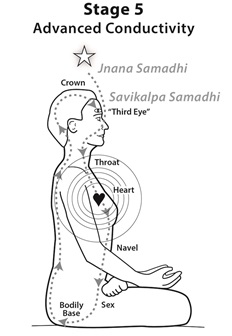
Nonetheless, by honoring the developmental unfolding of every person, which goes from prepersonal to personal to transpersonal (as modern psychology has proven), we can see it's important to first have a healthy sense of subjectivity, a strong ego. Indeed, this is why the first disciplines of Yoga (the yamas and niyamas) and of the Buddha's Eightfold Path involve moral and ethical practices, for they're the necessary foundation for higher spiritual development. Only then does someone begin to transcend the ego in real spiritual enlightenment or God-Realization. As integral psychologist Jack Engler once put it: “You have to be somebody before you can be nobody.” Wilber, in 1983, published an article in the Buddhist Journal The Middle Way titled “In Praise of the Ego: An Uncommon Buddhist Sermon,” which was a follow-up to his and transpersonal psychologist John Welwood's research a few years earlier: “On Ego Strength and Egolessness” published in the book The Meeting of the Ways: Explorations in East/West Psychology (1979). Resolving the seeming conflict between Western psychology, which encourages a strong ego, and Eastern meditation, which advocates ego transcendence, was a principle concern for the first generation of transpersonal psychologists. Wilber seemed to solve the dilemma best by suggesting that human life develops or evolves, stage-by-stage, level-by-level (for the most part) from an infant to an ego to Atman, by unfolding along a spectrum of consciousness evolution, growing from a baby to a buddha. This helped transform transpersonal psychology into an integral psychology, the “marriage of Freud and the Buddha.” Hence, according to this view, Western psychology deals best with ego development (Stages 1-3), while Eastern mysticism encourages ego-transcendence and devotional surrender (Stages 4-7). The integration of East-West, therefore, uses the wisdom of both views. Thus, the ego can be pictured as the “mid-point” of human development, which emerges in full strength with early adulthood, the completion of the Third Stage of Life. As Plotinus recognized (and Wilber later credited him in Up from Eden): “Humanity, in reality, is poised midway between gods and beasts, and inclines now to the one order, now to the other; some men grow to the divine, others to the brute, the greater number stand neutral.” Thus once a strong, balanced, and preferably healthy ego has emerged, then meditation and the practices of spirituality in the Fourth Stage of Life can appropriately and effectively be applied and practiced with the best results. Then when “ego-death” or complete self-transcendence occurs (initiating a satori), it's not such a shock to the system, so to speak, and the separate sense self (or ego-I) can stand in its enlightened position and still be functionally effective in the world. Meditation, in the language of Integral Psychology, therefore, involves a winding down of the horizontal translations on a certain level (such as the mental-ego) to initiate growth or vertical transformations into the higher stages of life. Wilber nicely summarizes: “[This] is precisely what meditation is designed to do; halt the mental-egoic translations so that transformations into the superconscious realms may begin.” Because meditation demands or trains the thinking mind to quiet down, it dislodges the embedded self and expands and loosens the self-contraction. Then the lower levels become more objective to the subject, instead of identifying with them exclusively. Wilber: “By assuming a witnessing stance of mindfulness, one's subjective structures start to become objective, and thus one begins to disidentify or detach from one's present level of development.” Therefore, although from outer appearances it seems the meditator is going within and turning away from the world, in truth, it is “a further going beyond, the discovery of a new and higher awareness with a new and wider identity [i.e., of soul and spirit]—and thus meditation is one of the single strongest antidotes to egocentrism and narcissism.” Adi Da, as a Sat-Guru will do, places meditation in the context of Perfect Enlightenment: In appearance, the meditative practice whereby the Condition of consciousness is Realized involves inversion upon the inner self, but it is not in fact a process of inversion upon the conditional and individuated self. Rather, right meditative inversion is the most direct means for transcending the ego, or the separate and separative self, by turning the essential or basic self-consciousness (or consciousness as attention) to the consideration of That in which attention (and thus the individuated and conditional self-consciousness) is always presently arising. 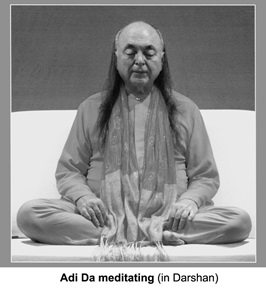
Meditation, as Integral Psychology emphasizes, is “a simple and natural continuation of the evolutionary process, where every going within is also a going beyond to a wider embrace.” Since meditation must break the exclusive identification with the egoic (or self-contracted) level of development (from any Stage of Life), it will also probably facilitate, as a byproduct, the emergence and unrepression of various forms of unconscious and shadow material, which can then be worked on in psychotherapy sessions, or with further conscious behavior modification. Meditation (or devotional surrender to God), in this case, becomes the driver for self-transcendence until Enlightenment, or when the ultimate Seventh Stage of Life is awakened and lived spontaneously. Wilber delightfully explains this possibility by ending a chapter titled “Development, Meditation, and the Unconscious” in Eye to Eye (1983):
And so proceeds meditation, which is simply higher development, which is simply higher evolution—a transformation from unity to unity until there is simple Unity, whereupon Brahman, in an unnoticed shock of recognition and final remembrance, grins silently to itself, closes its eyes, breathes deeply, and throws itself outward for the millionth time, losing itself in its manifestations for the sport and play of it all. Evolution then proceeds again, transformation by transformation, remembering more and more, unifying more and more, until every soul remembers Buddha, as Buddha, in Buddha—hereupon there is then no Buddha and no soul. And that is the final transformation.
Meditation is the evolutionary process in action within the interiors of mind, yet it transcends evolution too, for the desires for self-improvement can often be the yogic-self seeking for release, to move the kundalini up the spine, to see inner visions, to become a skillful loving bodhisattva, or some other idealized archetype, whereas true meditation is simple communion with the Divine Reality, as the Enlightened Masters have always maintained. There was Krishna (ca. 2nd millennium BCE), the Divine Avatar of India, who instructed his disciple Arjuna in the Bhagavad Gita on the proper practice of meditation: Disciplined through practice, his reason never straying, Controlling the body's gates, keeping the mind in the heart, Invoking the Infinite Spirit as the one eternal syllable OM, The illustrious Adi Shankara (8th century CE) also forcefully stated: “Utterly destroy [transcend] the ego. Control the many waves of distraction which it raises in the mind. Discern the reality and realize 'I Am That.' You are pure consciousness, the witness of all experiences. Your real nature is joy…. You are the Atman, the infinite Being, the pure, unchanging consciousness, which pervades everything. Your nature is bliss.” Not easy words to understand, which is why the loving grace of an enlightened Adept serves the process of higher transpersonal development so well. Adi Da Samraj, who is such an Adept, also reminds us of the utter simplicity of true surrender to God, which is the essence of real meditation, whether sitting on the cushion or living daily life: In the setting of formal devotional exercises or meditation, surrender is a matter of non-confrontation with the states of the body-mind. The body-mind should simply be observed. Then the intuitive or free-feeling being can enter naturally into the process of Remembrance and real meditation. And the Divine Power or Being is thus permitted to enter into the domain of self, which is the body-mind. Thus, as formal Remembrance or meditation continues, on the base of true surrender, the body-mind itself becomes attracted into the Current of the Life-Being. When this occurs, the body-mind should be easefully relaxed into the Current and permitted to be carried into the purifying and sublime states of devotional meditation…. In daily life, the devotee should gradually adapt to this same attitude of surrender under all conditions…. One is not to surrender to the random states of the body-mind. Rather, true surrender is a matter of the abandonment of attachment and reaction to the random states of the body-mind. Therefore, it is to cease the pattern both of controlling and being controlled by those states…. Practice true surrender, Divine Communion, love, service, and personal equanimity. Learn this. This is my most basic advice to you. 
Meditation, in other words, is not simply about quieting the self or creating ease (the goal of mindfulness) or even steadiness in the face of changes—that is a side effect of meditation, part of the equanimity arising from Divine Communion and ego-transcendence in the Living Spirit of Real God. Real meditation is abiding in Consciousness Itself, which is God or the Divine Reality (whether sitting on the meditation cushion or acting in the world). Meditation, paradoxically, is not a method of the self. Meditation is not an act of seeking, whether for ease or self-improvement, or even for Enlightenment. Meditation is an act of self-surrender or self-sacrifice into the Living Radiance that is God. Meditation is letting God breathe you till there is no “you” meditating, but only alive in the awareness of God Itself. This advanced meditation practice, therefore, can involve the highest samadhis, such as nirvakalpa, sahaj, and bhava samadhi (as the “Stage 7 'Open Eyes'” diagram indicates) while simultaneously radiating from the heart to Infinity (or as the “Simple Feeling of Being”). Enlightenment is as simple as that, yet we complicate it with our egoic contraction (throughout the First Six Stages of Life). The Great Traditions of God-Realization (or Whole-Body Enlightenment) do not recommend meditation for improving the self but for transcending the self. This does not mean evaporating the ego-I altogether—except when meditating while the separate “I” dissolves in Oneness or nondifference with the True Self—but rather in transcending (or letting go of) the desires and reactions created by attachments and aversions that keep the self bound in contraction and concern. In doing so—by meditating daily in bodily communion with Divine Spirit or Reality as It IS—the ego-I is liberated, not simply calmed or steadied. Then daily life may proceed from a position of Happiness and Love-Bliss being Awake or alive in Buddhahood. This is the Way of the Heart, not the way of the mind. It is true that meditation can ease stress, as Westerners likes to emphasize, but the real point behind meditation is to eliminate stress by seeing through the illusion of the separative ego-I, from which all stress originates. This is a principle message of Adi Da Samraj as well, who stands at the opening of the third millennium, as it is of Integral Psychology, which is integrating the modern psychologies of the past two centuries with the ancient wisdom of enlightened mysticism. Thus Wilber explained as the second millennium drew to a close: “There is precisely nothing occult or spooky, let alone psychotic, about true meditation. It is simply what an individual at this present stage of average-mode consciousness [in our current era] has to do in order to go beyond that stage in his or her own case. It is a simple and natural continuation of evolutionary transcendence, just as the body transcended matter, and mind transcended the body, so in meditation the soul transcends the mind and then Spirit transcends the soul.” Yet, such a profound task, such a “perfect practice” takes the expert guidance of qualified teachers, the real Masters of consciousness evolution, the genuine Sages, Siddhas, and Sat-Gurus of all persuasions and types (for people vary widely in their degree of development and disposition). With advanced-tip teachers and enlightened Masters here to serve and guide us, it becomes our moral duty as an evolving person, an ethical imperative as a growing adult that we learn to meditate—or engage in a similar contemplative practice (but truly, nothing exceeds meditation). We must do this individually, so that collectively humanity may realize our truest potential of Divine Enlightenment (culminating in the Seventh Stage of Life). Otherwise, without self-transcendence evolving into transpersonal spirituality by feeling (and knowing) God from the heart, we stay stuck in the mediocrity of our lower egoic adaptations and the mind games of the earlier stages of life (i.e., Stages 1-6). We all, therefore, need to access our more evolved meditation Masters, especially those authentic enlightened Adepts (not simply conventional meditation teachers), to instruct us about real meditation and authentic spiritual life (or sadhana), which go hand in hand.
Even the ancient Adepts with their surviving scriptures and admonitions can still teach us, if we take the time to read and study them. Yet, only a genuine Sat-Guru offers people a living relationship with the tangible power of spiritual transmission, an authentic energy exchange of Holy Spirit (or shaktipat), for they have developed (and been graced with) those capabilities that come from activating the Higher Stages of Life (4-7). To truly learn meditation, we must follow their recommendations, study their sacred texts and instructions, spend time in their spiritual company, and sincerely devote ourselves to their revelations and instruction—for they are the beacons to our own future evolution, not anachronisms of the premodern past but the light unto our glorious future.
|